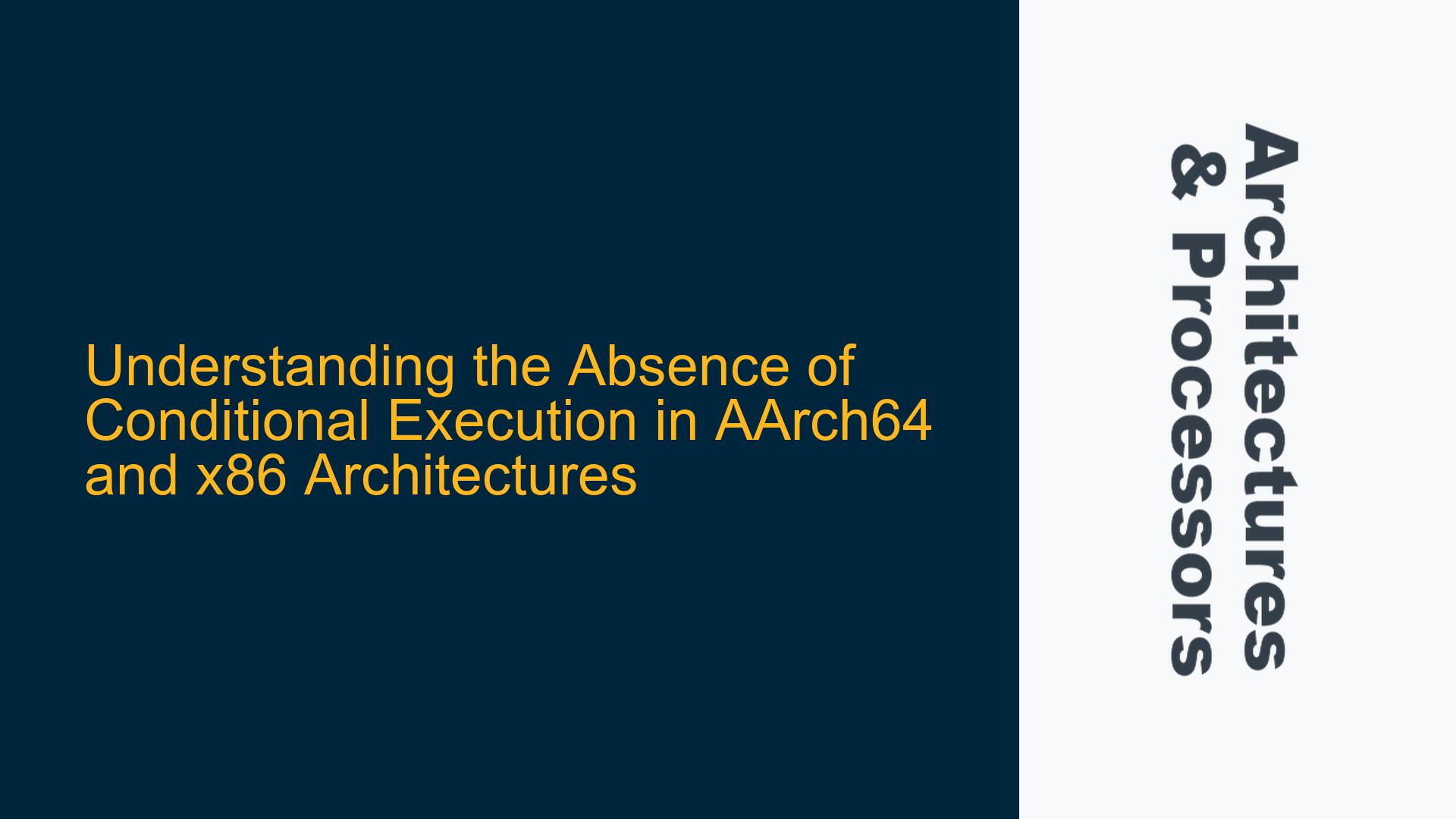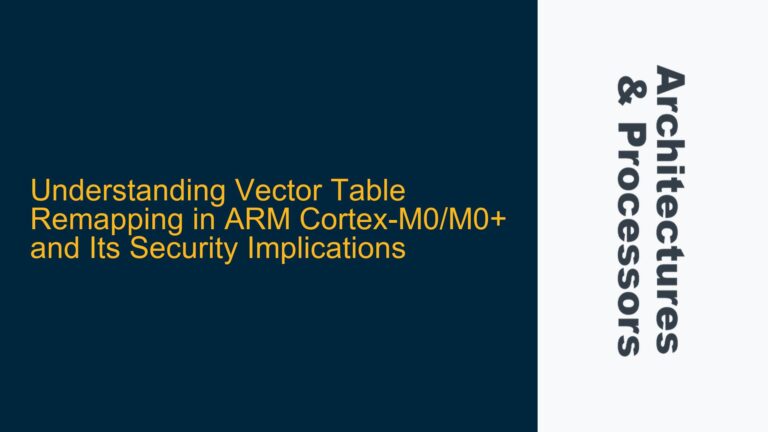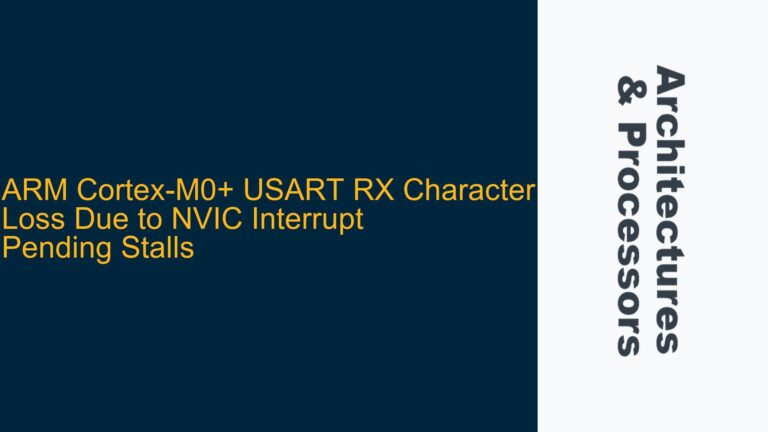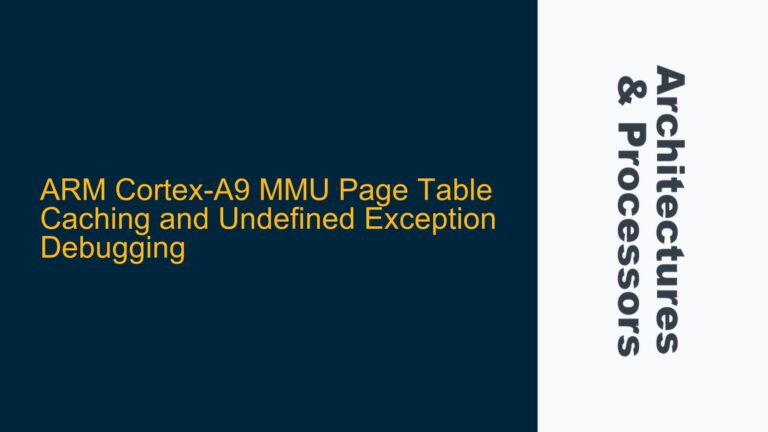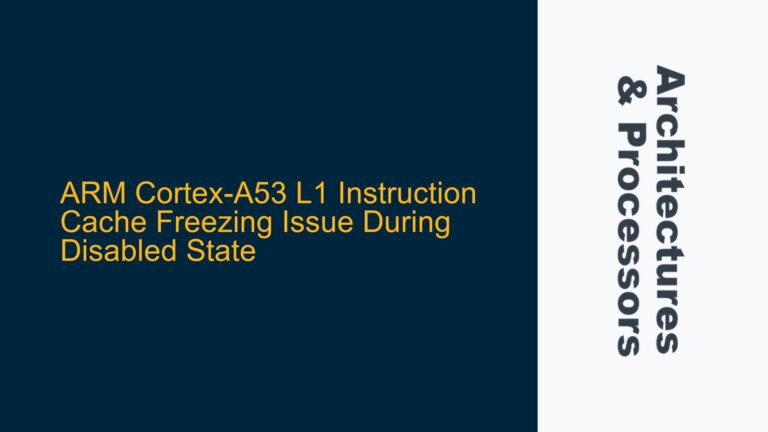ARM Cortex-A64 and x86: The Shift Away from Conditional Execution
Conditional execution, a feature prominently available in earlier ARM architectures such as ARMv7 and ARMv6, allowed instructions to be executed based on the state of specific condition flags. This feature was particularly useful for reducing the number of branch instructions, thereby improving code density and performance in certain scenarios. However, with the advent of ARMv8-A (AArch64) and modern x86 architectures, conditional execution has been significantly scaled back or entirely removed for most instructions. This shift has raised questions among developers and embedded systems engineers who are accustomed to leveraging conditional execution for optimizing performance-critical code.
The absence of conditional execution in AArch64 and x86 is not an oversight but a deliberate design choice influenced by several architectural and performance considerations. To understand this shift, it is essential to delve into the historical context, the trade-offs involved, and the implications for modern software development.
Opcode Space Constraints and Instruction Set Complexity
One of the primary reasons for the reduction in conditional execution support in AArch64 and x86 is the constraint on opcode space. In any instruction set architecture (ISA), the opcode space is a finite resource that must be carefully allocated to balance functionality, performance, and future extensibility. Conditional execution requires additional bits in the instruction encoding to specify the condition under which the instruction should execute. This consumes valuable opcode space that could otherwise be used for other purposes, such as introducing new instructions or expanding the addressing modes.
In ARMv7, conditional execution was supported for a wide range of instructions, which contributed to the complexity of the instruction set. Each instruction that supported conditional execution effectively had multiple variants, one for each possible condition code. This increased the complexity of the instruction decoder and the overall instruction set, making it more challenging to optimize the hardware for performance and power efficiency.
In AArch64, the decision was made to simplify the instruction set by removing conditional execution for most instructions. This simplification allows for a more streamlined instruction decoder and frees up opcode space for other features that provide greater overall performance benefits. For example, AArch64 introduces new instructions and addressing modes that are more aligned with the needs of modern software, such as improved support for SIMD (Single Instruction, Multiple Data) operations and enhanced memory access patterns.
Similarly, in x86, conditional execution has never been as pervasive as in ARMv7. The x86 architecture has historically relied on conditional move instructions and branch prediction to handle conditional logic. The focus in x86 has been on optimizing the execution of complex instructions and leveraging out-of-order execution to achieve high performance. The limited support for conditional execution in x86 is consistent with its design philosophy, which prioritizes instruction complexity and versatility over the simplicity and code density that conditional execution provides.
Performance and Power Efficiency Considerations
Another critical factor influencing the shift away from conditional execution is the impact on performance and power efficiency. While conditional execution can reduce the number of branch instructions and improve code density, it also introduces challenges for modern high-performance processors.
In modern CPUs, instruction pipelines are deeply optimized for speculative execution and branch prediction. Conditional execution can interfere with these optimizations by introducing additional dependencies and reducing the effectiveness of branch prediction. When instructions are conditionally executed, the CPU must evaluate the condition flags before determining whether to execute the instruction. This can introduce pipeline stalls and reduce the overall throughput of the processor.
Moreover, conditional execution can lead to inefficiencies in power consumption. In a deeply pipelined processor, the evaluation of condition flags and the potential execution of conditionally executed instructions can result in unnecessary power consumption, especially if the conditions are not met. This is particularly problematic in power-constrained environments, such as mobile devices and embedded systems, where energy efficiency is a critical concern.
In AArch64, the removal of conditional execution for most instructions aligns with the architectural goals of improving performance and power efficiency. By simplifying the instruction set and reducing the complexity of the instruction decoder, AArch64 processors can achieve higher clock speeds and better power efficiency. Additionally, the introduction of new instructions and addressing modes in AArch64 provides alternative mechanisms for achieving the same performance benefits that conditional execution once offered.
In x86, the limited support for conditional execution is consistent with the architecture’s focus on out-of-order execution and speculative execution. x86 processors rely heavily on branch prediction and speculative execution to achieve high performance, and the presence of conditional execution would complicate these mechanisms. Instead, x86 processors use conditional move instructions and other techniques to handle conditional logic without the need for pervasive conditional execution.
Alternative Mechanisms for Handling Conditional Logic
The reduction in conditional execution support in AArch64 and x86 does not mean that conditional logic cannot be efficiently handled in these architectures. Both AArch64 and x86 provide alternative mechanisms for handling conditional logic that are better suited to modern processor designs.
In AArch64, conditional execution is still supported for a limited set of instructions, such as conditional branches and conditional select instructions. These instructions allow for efficient handling of conditional logic without the need for pervasive conditional execution. For example, the CSEL (Conditional Select) instruction in AArch64 allows for the selection of one of two source registers based on a condition, providing a mechanism for implementing conditional logic without the need for branch instructions.
Additionally, AArch64 introduces new instructions and addressing modes that can be used to optimize conditional logic. For example, the CCMP (Conditional Compare) and CSET (Conditional Set) instructions provide efficient mechanisms for evaluating complex conditions and setting flags based on the result. These instructions can be used to implement conditional logic in a way that is more efficient than traditional conditional execution.
In x86, conditional logic is typically handled using conditional move instructions (CMOVcc) and branch prediction. Conditional move instructions allow for the conditional assignment of a value to a register based on a condition, without the need for a branch instruction. This can reduce the number of branch instructions in the code and improve performance by avoiding branch mispredictions.
Furthermore, x86 processors leverage sophisticated branch prediction mechanisms to handle conditional logic efficiently. Branch prediction allows the processor to speculatively execute instructions based on the predicted outcome of a branch, reducing the performance impact of conditional logic. While branch prediction is not perfect, modern x86 processors have highly accurate branch predictors that minimize the performance impact of conditional logic.
Implications for Software Development
The shift away from conditional execution in AArch64 and x86 has important implications for software development, particularly for performance-critical code. Developers accustomed to leveraging conditional execution in ARMv7 will need to adapt their coding practices to take advantage of the alternative mechanisms available in AArch64 and x86.
In AArch64, developers should focus on using the available conditional instructions, such as CSEL, CCMP, and CSET, to implement conditional logic efficiently. These instructions provide a more streamlined and efficient way to handle conditional logic compared to traditional conditional execution. Additionally, developers should take advantage of the new instructions and addressing modes in AArch64 to optimize their code for performance and power efficiency.
In x86, developers should leverage conditional move instructions and branch prediction to handle conditional logic efficiently. Conditional move instructions can be used to reduce the number of branch instructions in the code, improving performance by avoiding branch mispredictions. Additionally, developers should be aware of the branch prediction capabilities of the target processor and structure their code to take advantage of these capabilities.
Overall, the shift away from conditional execution in AArch64 and x86 reflects the evolving priorities of modern processor design. While conditional execution provided benefits in earlier architectures, the constraints of opcode space, performance, and power efficiency have led to its reduction in modern architectures. By understanding the reasons behind this shift and adapting their coding practices accordingly, developers can continue to write efficient and high-performance code for AArch64 and x86 processors.
Conclusion
The absence of conditional execution in AArch64 and x86 architectures is a deliberate design choice driven by the need to optimize opcode space, performance, and power efficiency. While conditional execution provided benefits in earlier architectures, the constraints of modern processor design have led to its reduction in favor of alternative mechanisms for handling conditional logic. Developers working with AArch64 and x86 should adapt their coding practices to take advantage of the available conditional instructions and branch prediction mechanisms to achieve optimal performance and power efficiency. By understanding the architectural trade-offs and leveraging the available tools, developers can continue to write efficient and high-performance code for modern processors.
